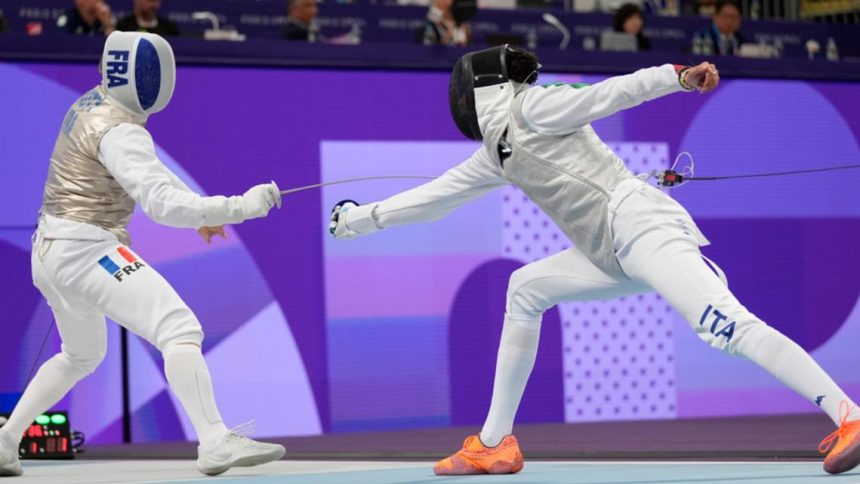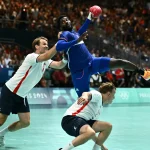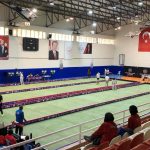Fencing is a combat sport where two athletes use swords to score points by striking their opponent in designated areas of the body. It consists of three disciplines, each with its own weapon and rules:
- Why is Fencing Popular in the Global Sports Market?
- About Fencing | Apex Fencing Academy
- Fencing 101: Olympic history, records and results
- Fencing Equipment Market to Grow by USD 61.7 Million (2024-2028) as Combat…
- Sports Technology Market Size & Share Forecast Report 2030
- Important Global Fencing Events
- How to Get Started in Fencing and Become Good
- Critical Perspective
- Conclusion
- Foil: A light weapon where points are scored by touching the opponent’s torso with the tip. Only the tip counts, and there are strict “right-of-way” rules determining who scores in simultaneous hits.
- Épée: A heavier weapon where points are scored with the tip anywhere on the opponent’s body. There are no right-of-way rules, so simultaneous hits award points to both fencers.
- Sabre: A weapon where points can be scored with the tip or edge, targeting the upper body (above the waist, including head and arms). Right-of-way rules apply.
Fencing bouts occur on a 14-meter-long piste, with athletes aiming to score 15 points in individual matches (or 45 in team events) through three-minute periods. It’s often called “physical chess” due to its blend of athleticism, strategy, and mental agility. Protective gear, including masks, jackets, and gloves, ensures safety, and electronic scoring systems register touches. Fencing traces its roots to historical swordsmanship, evolving into a modern sport in the late 19th century, and has been part of every modern Olympic Games since 1896.
Why is Fencing Popular in the Global Sports Market?
Fencing’s popularity in the global sports market, while niche compared to sports like soccer or basketball, stems from several factors:
- Historical and Cultural Appeal: Fencing carries a romanticized legacy tied to dueling, swashbuckling heroes, and aristocratic traditions, captivating audiences and participants. Its mystique draws in those intrigued by swordplay, as seen in pop culture references like The Princess Bride or Star Wars.
- Olympic Prestige: As one of only five sports featured in every modern Olympics, fencing enjoys global visibility. Its inclusion since 1896 and consistent medal events (12 in Paris 2024) attract sponsorships and media coverage, boosting its market presence.
- Accessibility and Inclusivity: Fencing doesn’t require exceptional physical attributes like height or brute strength, making it accessible to diverse ages, genders, and body types. Women have competed in Olympic fencing since 1924, and initiatives like wheelchair fencing expand its reach. Its mental and physical benefits—burning ~400 calories per workout for a 150-pound person—appeal to fitness enthusiasts.
- Technological Advancements: Innovations like electronic scoring, advanced materials (e.g., maraging steel blades, polycarbonate masks), and AI-driven analytics enhance performance and viewer experience, aligning fencing with modern sports trends. The fencing equipment market is projected to grow by USD 61.7 million from 2024-2028, driven by combat sports’ rising popularity.
- Global Reach with Niche Passion: While not as widespread as soccer (4 billion fans) or basketball (2.2 billion), fencing has dedicated followings in countries like France, Italy, Russia, South Korea, and the U.S. France has 10 times more registered fencers than Italy despite similar elite success, showing regional variation. Its global competitive scene, governed by the Fédération Internationale d’Escrime (FIE) with 155 national federations, sustains a steady fanbase.
- Youth Engagement: Efforts to introduce fencing to younger audiences through foam/plastic swords and school programs (e.g., Scotland’s Plastic-and-Foam Fencing FunLeague) lower entry barriers. Its intellectual challenge and lack of “bench time” appeal to kids seeking individual sports.
Despite these factors, fencing remains less popular in some regions (e.g., the U.S. outside urban centers like New York) due to high equipment costs (beginner kits ~USD 100-120, expert kits up to USD 1,000) and limited grassroots infrastructure. However, its growth in women’s participation and technological integration signals increasing market relevance.
Important Global Fencing Events
Fencing’s global competitive calendar includes several prestigious events:
- Olympic Games: The pinnacle of fencing, held every four years, featuring 12 medal events (individual and team for men’s and women’s foil, épée, and sabre). Paris 2024 (July 27-August 4) showcased stars like France’s Romain Cannone and the U.S.’s Lee Kiefer, who won individual foil gold in Tokyo 2020.
- World Fencing Championships: Organized annually by the FIE (except in Olympic years), these are the top non-Olympic competitions. Recent champions include Cannone (épée, 2022) and China’s Sun Yiwen (épée, 2019).
- FIE World Cup and Grand Prix Series: These international tournaments run throughout the year, offering ranking points for Olympic qualification. Events like the Doha Grand Prix or Tallinn Épée World Cup draw top fencers and significant viewership.
- European Championships: A major regional competition for European nations, which dominate fencing (e.g., France, Italy, Russia). Held annually, it’s a key proving ground for Olympic hopefuls.
- Junior and Cadet World Championships: For athletes under 20 and 17, respectively, these events nurture young talent. They’re critical for identifying future stars like the U.S.’s Mariel Zagunis, who won Olympic sabre gold in 2004 at age 19.
These events drive the sports events market, valued at USD 452.79 billion in 2024 with a projected 7.2% CAGR through 2030, as they attract sponsorships, tourism, and media rights revenue. Fencing’s Olympic and World Championship broadcasts benefit from the global sports market’s digital streaming trend, enhancing fan engagement.
How to Get Started in Fencing and Become Good
Getting Started (Young or Old)
- Find a Fencing Club:
- Locate a local club through national federations like USA Fencing, British Fencing, or the FIE’s directory. Urban areas often have more options; for example, New York is a U.S. fencing hub. Clubs offer beginner classes for all ages, often using foam swords for kids to reduce costs and safety concerns.
- Example: Apex Fencing Academy in the U.S. provides beginner programs emphasizing fun and fundamentals.
- Acquire Basic Equipment:
- Beginners need a mask, jacket, glove, and weapon (foil, épée, or sabre). A starter kit costs ~USD 100-120, though rentals are often available at clubs. Avoid buying high-end gear initially, as FIE-certified equipment for competitions is pricier (~USD 1,000).
- Protective gear ensures safety, and weapons are blunted with no sharp edges.
- Take Lessons:
- Group classes teach footwork, blade work, and rules. Private lessons (more expensive) accelerate progress but aren’t mandatory for beginners. Costs vary, with group sessions often ~USD 20-50/month and private lessons ~USD 20-50/hour.
- Coaches emphasize sportsmanship, strategy, and fitness, making fencing a mental and physical workout.
- Join a Community:
- Fencing clubs foster camaraderie, and local tournaments (divided by age and skill) guarantee competition time. Unlike team sports, fencers don’t “sit the bench,” ensuring active participation.
- School programs or university clubs are great entry points, especially in countries like France or South Korea, where fencing is more embedded.
- Understand the Disciplines:
- Try all three weapons to find your preference. Foil suits analytical thinkers, épée rewards patience, and sabre favors aggressive, fast-paced fencers. Most clubs let beginners experiment before specializing.
Becoming Good at Fencing
- Master Fundamentals:
- Footwork: Agility and balance are critical. Practice lunges, advances, retreats, and cross-steps to control distance on the piste.
- Blade Work: Develop precision in attacks (e.g., thrust, lunge) and defenses (e.g., parries, ripostes). Drills with coaches or partners hone reflexes.
- Tactics: Learn to read opponents’ patterns and adapt strategies. Right-of-way rules (in foil and sabre) require understanding priority in attacks.
- Compete Regularly:
- Enter local and regional tournaments (e.g., USA Fencing’s Division II/III events) to gain experience. Losses teach more than wins, revealing weaknesses to address.
- Progress to national events like North American Cups (NACs) or international junior competitions to build a competitive resume.
- Train Consistently:
- Physical conditioning (cardio, strength, flexibility) enhances speed and endurance. Fencing workouts burn significant calories, aiding fitness
- Mental training—focus, adaptability, and stress management—is equally vital. Visualization and studying opponents’ footage sharpen decision-making.
- Work with Qualified Coaches:
- A skilled coach tailors training to your style and goals. In the U.S., coach shortages hinder growth, so seek certified instructors through national federations.
- Example: Learning from Olympic champions, as offered by some academies, provides elite insights.
- Specialize and Set Goals:
- Choose one weapon to master, as most elite fencers specialize. Set short-term goals (e.g., winning local tournaments) and long-term goals (e.g., national team selection).
- Track progress through rankings (e.g., FIE points for World Cup events) and aim for milestones like Junior World Championships or Olympic qualification.
- Leverage Technology:
- Use video analysis to review bouts and refine technique. AI tools like Allez Go, which display right-of-way in real-time, can help understand complex rules. Wearables track performance metrics, optimizing training.
- Persist Through Challenges:
- Fencing is expensive and demanding, with equipment replacements and travel costs adding up. Seek scholarships or club subsidies to offset expenses.
- Plateaus and losses are common; resilience and learning from setbacks are key to long-term success.
Young vs. Older Athletes
- Young Athletes: Start as early as 6-8 with foam swords in fun, low-pressure programs. Youth tournaments (e.g., British Youth Championships) build skills progressively. Parental support and affordable clubs are crucial. Early exposure to competition fosters confidence and discipline.
- Older Athletes: Adults can begin at any age, as fencing rewards strategy over raw athleticism. Chair fencing or recreational leagues suit those with physical limitations. Older fencers may progress slower but can excel in veteran categories (e.g., 40+ tournaments).
Critical Perspective
While fencing’s Olympic status and technological advancements boost its market appeal, its growth is hampered by structural issues. In the U.S., USA Fencing’s focus on elite athletes and Olympic medals neglects grassroots development, with insufficient coach training and local tournaments. The FIE’s pursuit of TV deals over streaming innovation limits global accessibility, especially for a sport with a dispersed audience. High costs deter broader participation, particularly in developing nations, despite efforts to make fencing inclusive. These barriers suggest fencing’s popularity is concentrated in specific regions and demographics, and its global market share could stagnate without systemic reforms.
Conclusion
Fencing is a dynamic sport blending physical prowess with mental strategy, popular for its historical allure, Olympic prestige, and accessibility. Major events like the Olympics and World Championships drive its global market presence, supported by a growing equipment and technology sector. Aspiring fencers, young or old, can start at local clubs, progress through consistent training and competition, and leverage technology to excel. However, addressing cost barriers and grassroots neglect is critical to unlocking fencing’s full potential in the global sports market. For more details, check USA Fencing (usafencing.org) or the FIE (fie.org) for clubs and competitions near you.














